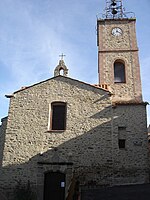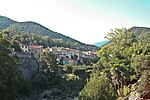Saint-Félix de Ropidera Church

The Saint-Félix de Ropidera Church (Catalan: Sant Feliu de Ropidera) is a ruined, fortified Romanesque church located in the deserted medieval village of Ropidera, in the commune of Rodès, in the French department of Pyrénées-Orientales. Built in the 11th century, Saint-Félix church may have been abandoned as early as the 15th century, but remained the seat of a parish church until the 18th century. Built on the steep ledges of a plateau overlooking the River Têt, Saint-Félix is fifteen meters long and five meters wide. The barrel vault of its single nave collapsed, as did part of the semi-dome vault of its apse, following the gradual abandonment of the village of Ropidera in the late Middle Ages. The church's location, slightly south of the border between Spain and France established by the Treaty of Corbeil in 1258, led the authorities to build a high watchtower above its apse in the late 13th or early 14th century. A fifteen-metre-high corner of this tower remains.
Excerpt from the Wikipedia article Saint-Félix de Ropidera Church (License: CC BY-SA 3.0, Authors, Images).Saint-Félix de Ropidera Church
Cami de les Cases, Prades
Geographical coordinates (GPS) Address Nearby Places Show on map
Geographical coordinates (GPS)
| Latitude | Longitude |
|---|---|
| N 42.665833333333 ° | E 2.5419444444444 ° |
Address
Cami de les Cases
Cami de les Cases
66320 Prades
Occitania, France
Open on Google Maps











